Red Pill screenshots: J-20 trial by fire
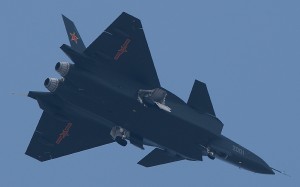 We have been busy recently revamping the databases of Red Pill with new schema additions that allow new rich modeling functionality. This doesn’t mean however that we have overlooked the latest developments in military platforms and associated systems; China’s new J-20 stealth fighter being a case in point. We ran a test scenario to evaluate its merits against a potential regional adversary’s forces and provided a number of screenshots with accompanying description. Let us see how the plot unfolds. (Click shots for full size)
We have been busy recently revamping the databases of Red Pill with new schema additions that allow new rich modeling functionality. This doesn’t mean however that we have overlooked the latest developments in military platforms and associated systems; China’s new J-20 stealth fighter being a case in point. We ran a test scenario to evaluate its merits against a potential regional adversary’s forces and provided a number of screenshots with accompanying description. Let us see how the plot unfolds. (Click shots for full size)
————-
Yellow Sea, September 21, 2018. The relationship between Japan and China is colder than ever, and Japan is staging fighter sweeps off the coast of China on an almost daily basis. The Chinese decide to teach the Japanese a lesson, and launch their latest J-20 fighters to intercept…
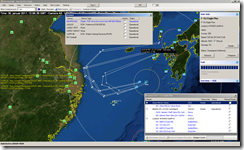 The Japanese have sortied 8x F-15Js to carry out today’s sweep. Each fighter is armed with a standard combat loadout of 4x AAM-4 MR AAMs and 4x AAM-5 SR AAMs. An E-767 AWACS will provide early warning for the fighters as they proceed beyond the mainland radar coverage, and itself is guarded by another pair of F-15Js. The detection range of the E-767’s powerful E-band AN/APY-2 radar is only moderately degraded by the J-20’s stealth, which is optimized for higher-frequency radars like the F-15J’s I-band AN/APG-63. The Japanese have sortied 8x F-15Js to carry out today’s sweep. Each fighter is armed with a standard combat loadout of 4x AAM-4 MR AAMs and 4x AAM-5 SR AAMs. An E-767 AWACS will provide early warning for the fighters as they proceed beyond the mainland radar coverage, and itself is guarded by another pair of F-15Js. The detection range of the E-767’s powerful E-band AN/APY-2 radar is only moderately degraded by the J-20’s stealth, which is optimized for higher-frequency radars like the F-15J’s I-band AN/APG-63. |
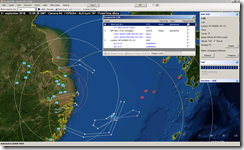 A Chinese KJ-2000 AWACS on patrol station picks up the approaching fighters at over 250nm, and no fewer than sixteen J-20s are scrambled to take off. The Japanese fighters are flying different routes each time, so ambushing the aircraft at a pre-set point is nearly impossible. However the Chinese are confident that the J-20’s speed and range, coupled with excellent coverage from their early warning radar network, will give them a fair chance of overwhelming the Japanese fighters. Under control of the KJ-2000, eight of the J-20s head straight for the incoming fighters while the rest break off to the side and will attempt flank attacks on the Japanese AWACS aircraft. A Chinese KJ-2000 AWACS on patrol station picks up the approaching fighters at over 250nm, and no fewer than sixteen J-20s are scrambled to take off. The Japanese fighters are flying different routes each time, so ambushing the aircraft at a pre-set point is nearly impossible. However the Chinese are confident that the J-20’s speed and range, coupled with excellent coverage from their early warning radar network, will give them a fair chance of overwhelming the Japanese fighters. Under control of the KJ-2000, eight of the J-20s head straight for the incoming fighters while the rest break off to the side and will attempt flank attacks on the Japanese AWACS aircraft. |
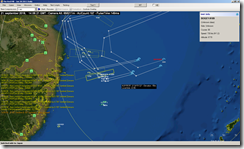 The KJ-2000 and its pair of Su-30MKK2 escorts are clearing the scene while the J-20s supercruise toward their targets at Mach 1.2, ca 20k ft altitude. An HD-5 Beagle with ECM gear is attempting to jam the E-767’s radar to degrade its effectiveness, hence delaying initial detection of the approaching J-20s. However, the antiquated jammers cannot overcome the sophisticated ECCM of the AN/APY-2. Moreover, the HD-5’s sub-optimal off-angle positioning severely reduces the jammers effective power. As a result, the AWACS radar burns through the jamming and starts picking up the J-20s at 135-155nm. The jammer is still causing problems for the APY-2, though, and holding a track is difficult – hence the uncertainty zones around the contacts. The KJ-2000 and its pair of Su-30MKK2 escorts are clearing the scene while the J-20s supercruise toward their targets at Mach 1.2, ca 20k ft altitude. An HD-5 Beagle with ECM gear is attempting to jam the E-767’s radar to degrade its effectiveness, hence delaying initial detection of the approaching J-20s. However, the antiquated jammers cannot overcome the sophisticated ECCM of the AN/APY-2. Moreover, the HD-5’s sub-optimal off-angle positioning severely reduces the jammers effective power. As a result, the AWACS radar burns through the jamming and starts picking up the J-20s at 135-155nm. The jammer is still causing problems for the APY-2, though, and holding a track is difficult – hence the uncertainty zones around the contacts. |
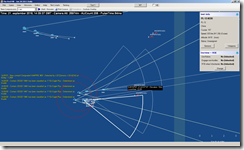
At 5nm the lead pair of J-20s open fire with PL-12 ARH medium-range AAMs. The missiles are fired in active mode at point blank range, giving the F-15Js near-zero reaction time. The second pair of J-20s to the north have launched another volley of PL-12s at another pair of F-15Js. No Japanese AAM launch has been detected yet. |
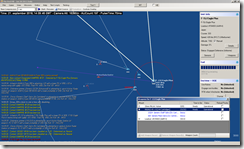
The Japanese return fire with a volley of AAM-4s and AAM-5s, and within seconds three F-15Js and two J-20s have been shot down! The clash is short and brutal, with three J-20s and four F-15Js lost. |
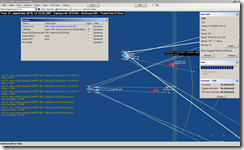 The four Japanese F-15Js to the north have been alerted by the E-767, and ripple-fire their AAM-4s at four approaching J-20s. The AN/APG-63 has not yet picked up the J-20s despite being within 20nm, so the AAM-4s are launched in bearing-only mode using cues from the F-15J’s IRST along with target info passed on from the E-767 via datalink. The four Japanese F-15Js to the north have been alerted by the E-767, and ripple-fire their AAM-4s at four approaching J-20s. The AN/APG-63 has not yet picked up the J-20s despite being within 20nm, so the AAM-4s are launched in bearing-only mode using cues from the F-15J’s IRST along with target info passed on from the E-767 via datalink. |
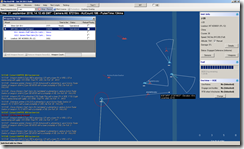
Three J-20s die in the initial missile exchange along with a single F-15J. Two more F-15Js are about to succumb to PL-12s while the last F-15J dashes in on the surviving J-20 for an AAM-5 shot. The sole surviving F-15J then disengages and heads home in a hurry. |
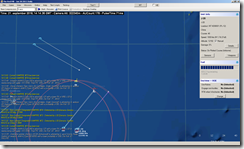
Another eight J-20s approach from the north and south in a pincer maneuver, heading straight for the E-767 and its escorts at Mach 1.74, 40k ft. Someone is going to get hurt. |
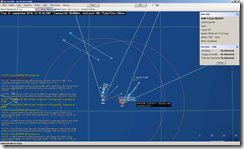 The two F-15Js defending the E-767 are determined to stop the southern J-20s and ripple-fire two AAM-4s at each of the four J-20s. However, it is too late: The J-20s have reached missile launch range against the E-767 and a pair of PL-12s have been launched by the time the AAM-4s start impacting. Seconds later, one J-20, two F-15Js and the E-767 are all dead. The two F-15Js defending the E-767 are determined to stop the southern J-20s and ripple-fire two AAM-4s at each of the four J-20s. However, it is too late: The J-20s have reached missile launch range against the E-767 and a pair of PL-12s have been launched by the time the AAM-4s start impacting. Seconds later, one J-20, two F-15Js and the E-767 are all dead. |
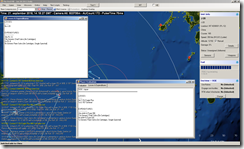
The scenario ends, with possibly a Chinese tactical victory (the AWACS kill counts for a lot) at significant cost. Losses & munitions/stores expenditures for both sides are displayed. |
| Some afterthoughts:
* Modelling a combat aircraft with only a handful of definite technical data at hand is always a chancy endeavor. The assumptions made for the J-20 at the present time are as follows:
It will certainly be interesting to re-run this scenario once more technical information is released about this aircraft and the above assumptions are revised. * This scenario took place in 2018, so the F-15Js were armed with modern ARH AAM-4s rather than SARH AIM-7Ms. They could therefore “blind-fire” their missiles at the J-20s based on contact information from the E-767 and their IRSTs, largely negating the J-20s’ stealth. The detection range of the APG-63 vs. J-20 is only 10-15nm, which would have rendered the AIM-7M (which depends on radar illumination from the launching aircraft for guidance) nearly useless. This underscores the severe limitations of SARH-based missile systems against stealth targets and the benefits of AMRAAM-class weapons in this case. * Asset positioning is critical. We already saw how the HD-5 jammer’s relative ineffectiveness was partially owed to its off-angle position relative to the fighters it was attempting to mask. On the other side, so long as the E-767 stayed close to the F-15Js, allowing them to engage the J-20s at the max effective of the AAM-4, the kill ratio was nearly 1:1. Had the E-767 operated further back from the fighters, had it been shot down early in the fight, or had it been been forced to backtrack or shut off its radar under threat of anti-AWACS ARMs, the outcome would have been very different. The F-15Js would have been forced to rely almost exclusively on their IRSTs, likely suffering disproportionate losses. Now, about the DF-21D ASBM… |
Comments
One Response to “Red Pill screenshots: J-20 trial by fire”
Leave a Reply
You must be logged in to post a comment.






Guys,
extremely impressing, wonderful GUI. Congrats on what you´ve achieved so far and best wishes for the work left. You´ll no doubt create an excellent sim.
Ralf